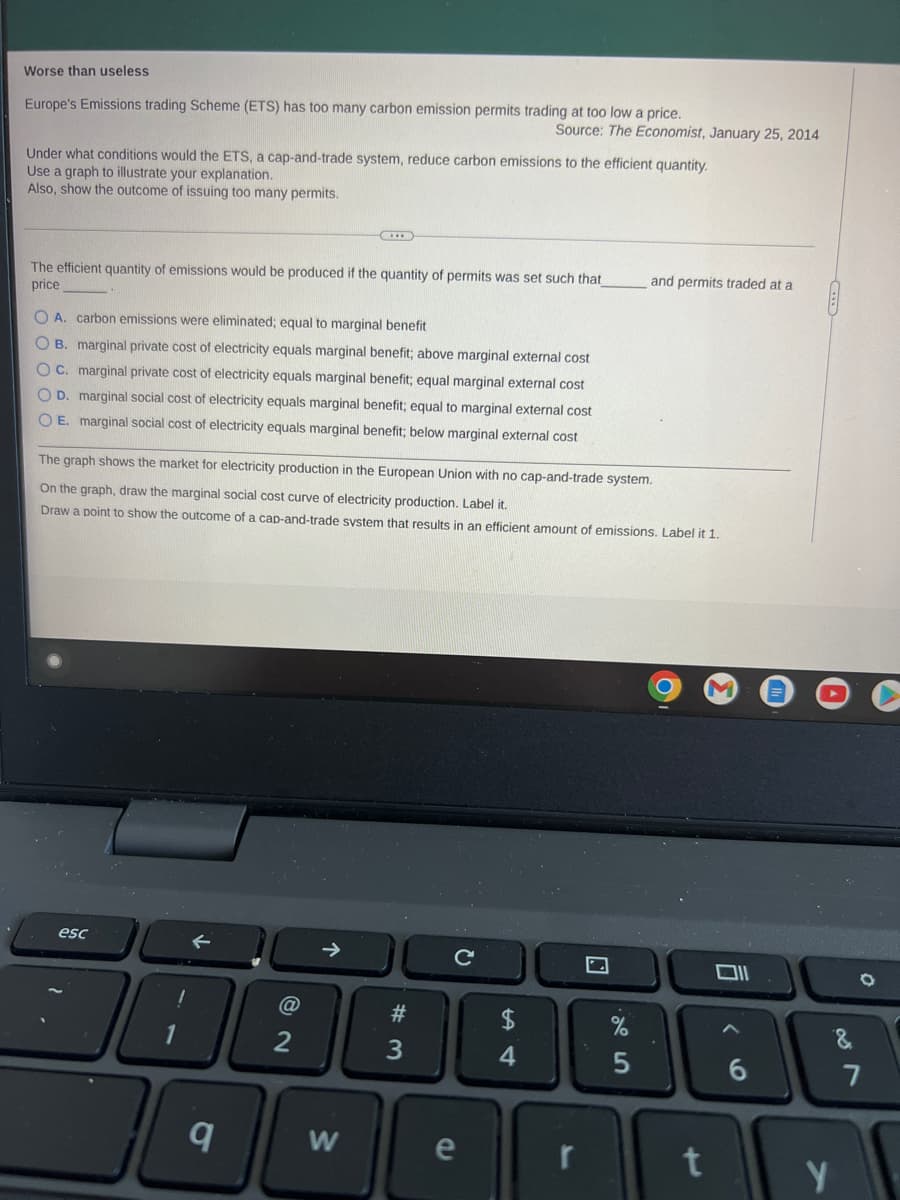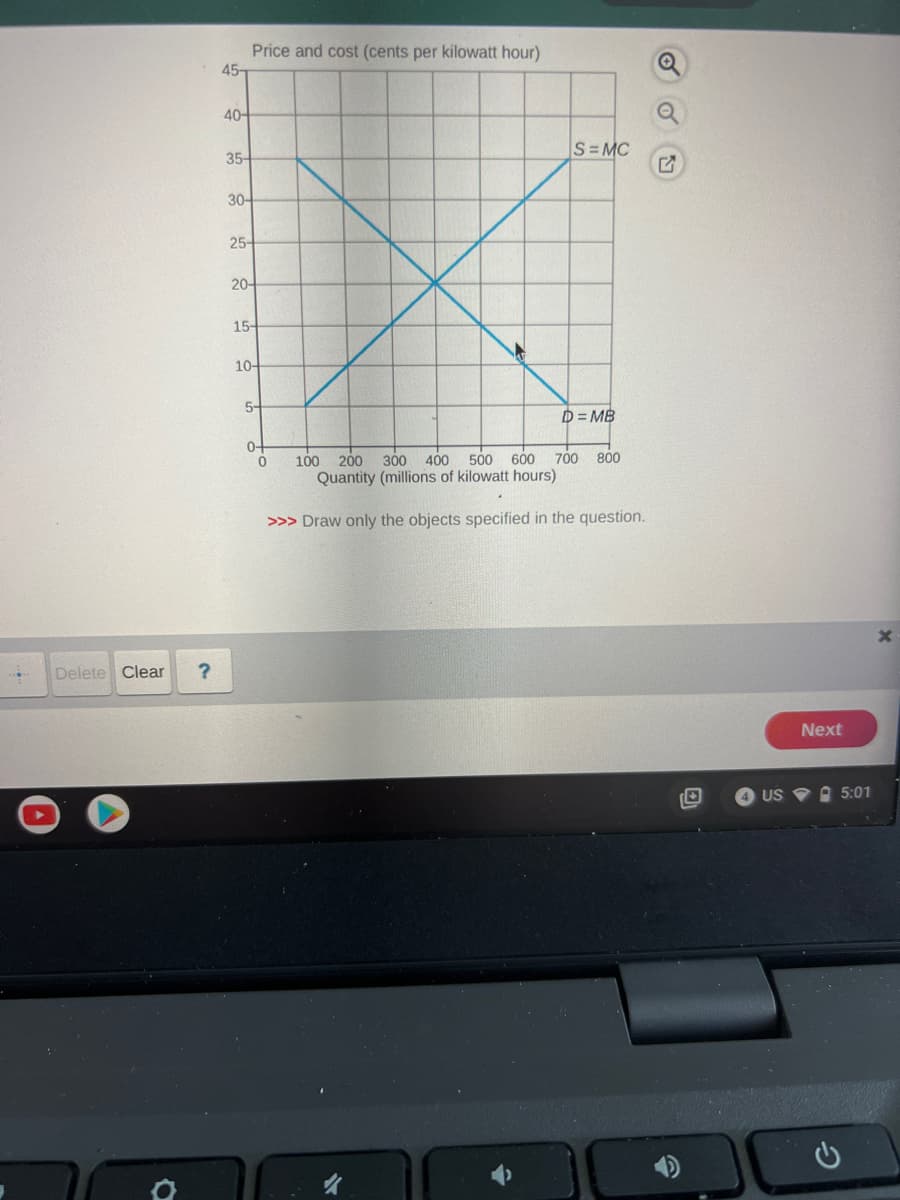Worse than useless Europe's Emissions trading Scheme (ETS) has too many carbon emission permits trading at too low a price. Source: The Economist, January 25, 2014 Under what conditions would the ETS, a cap-and-trade system, reduce carbon emissions to the efficient quantity. Use a graph to illustrate your explanation. Also, show the outcome of issuing too many permits. *** The efficient quantity of emissions would be produced if the quantity of permits was set such that_ price A. carbon emissions were eliminated; equal to marginal benefit B. marginal private cost of electricity equals marginal benefit; above marginal external cost OC. marginal private cost of electricity equals marginal benefit; equal marginal external cost D. marginal social cost of electricity equals marginal benefit; equal to marginal external cost OE. marginal social cost of electricity equals marginal benefit; below marginal external cost and permits traded at a The graph shows the market for electricity production in the European Union with no cap-and-trade system. On the graph, draw the marginal social cost curve of electricity production. Label it. Draw a point to show the outcome of a cap-and-trade system that results in an efficient amount of emissions. Label it 1. B
Worse than useless Europe's Emissions trading Scheme (ETS) has too many carbon emission permits trading at too low a price. Source: The Economist, January 25, 2014 Under what conditions would the ETS, a cap-and-trade system, reduce carbon emissions to the efficient quantity. Use a graph to illustrate your explanation. Also, show the outcome of issuing too many permits. *** The efficient quantity of emissions would be produced if the quantity of permits was set such that_ price A. carbon emissions were eliminated; equal to marginal benefit B. marginal private cost of electricity equals marginal benefit; above marginal external cost OC. marginal private cost of electricity equals marginal benefit; equal marginal external cost D. marginal social cost of electricity equals marginal benefit; equal to marginal external cost OE. marginal social cost of electricity equals marginal benefit; below marginal external cost and permits traded at a The graph shows the market for electricity production in the European Union with no cap-and-trade system. On the graph, draw the marginal social cost curve of electricity production. Label it. Draw a point to show the outcome of a cap-and-trade system that results in an efficient amount of emissions. Label it 1. B
Principles of Economics 2e
2nd Edition
ISBN:9781947172364
Author:Steven A. Greenlaw; David Shapiro
Publisher:Steven A. Greenlaw; David Shapiro
Chapter12: Environmental Protection And Negative Externalities
Section: Chapter Questions
Problem 10SCQ: Suppose a city releases 16 million gallons of raw sewage into a nearby lake. Table 12.8 shows the...
Related questions
Question

Transcribed Image Text:Worse than useless
Europe's Emissions trading Scheme (ETS) has too many carbon emission permits trading at too low a price.
Source: The Economist, January 25, 2014
Under what conditions would the ETS, a cap-and-trade system, reduce carbon emissions to the efficient quantity.
Use a graph to illustrate your explanation.
Also, show the outcome of issuing too many permits.
The efficient quantity of emissions would be produced if the quantity of permits was set such that_
price
O A. carbon emissions were eliminated; equal to marginal benefit
OB. marginal private cost of electricity equals marginal benefit; above marginal external cost
OC. marginal private cost of electricity equals marginal benefit; equal marginal external cost
OD. marginal social cost of electricity equals marginal benefit; equal to marginal external cost
OE. marginal social cost of electricity equals marginal benefit; below marginal external cost
The graph shows the market for electricity production in the European Union with no cap-and-trade system.
On the graph, draw the marginal social cost curve of electricity production. Label it.
Draw a point to show the outcome of a cap-and-trade system that results in an efficient amount of emissions. Label it 1.
esc
←
q
@
2
↑
W
# 3
e
54
r
7
and permits traded at a
5
t
Oll
6
&
Y
O
7

Transcribed Image Text:Delete Clear
?
45-
40-
35-
Price and cost (cents per kilowatt hour)
30-
25-
20-
15-
10-
5-
0-
S=MC
0
D=MB
100 200 300 400 500 600 700 800
Quantity (millions of kilowatt hours)
>>> Draw only the objects specified in the question.
Q
Next
US 5:01
Expert Solution
This question has been solved!
Explore an expertly crafted, step-by-step solution for a thorough understanding of key concepts.
Step by step
Solved in 3 steps with 1 images

Knowledge Booster
Learn more about
Need a deep-dive on the concept behind this application? Look no further. Learn more about this topic, economics and related others by exploring similar questions and additional content below.Recommended textbooks for you

Principles of Economics 2e
Economics
ISBN:
9781947172364
Author:
Steven A. Greenlaw; David Shapiro
Publisher:
OpenStax

Principles of Microeconomics
Economics
ISBN:
9781305156050
Author:
N. Gregory Mankiw
Publisher:
Cengage Learning

Essentials of Economics (MindTap Course List)
Economics
ISBN:
9781337091992
Author:
N. Gregory Mankiw
Publisher:
Cengage Learning

Principles of Economics 2e
Economics
ISBN:
9781947172364
Author:
Steven A. Greenlaw; David Shapiro
Publisher:
OpenStax

Principles of Microeconomics
Economics
ISBN:
9781305156050
Author:
N. Gregory Mankiw
Publisher:
Cengage Learning

Essentials of Economics (MindTap Course List)
Economics
ISBN:
9781337091992
Author:
N. Gregory Mankiw
Publisher:
Cengage Learning



Microeconomics: Principles & Policy
Economics
ISBN:
9781337794992
Author:
William J. Baumol, Alan S. Blinder, John L. Solow
Publisher:
Cengage Learning